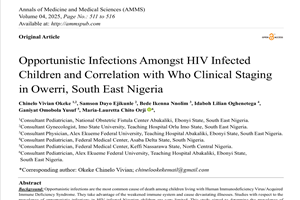Opportunistic Infections Amongst HIV Infected Children and Correlation with Who Clinical Staging in Owerri, South East Nigeria
Authors
##plugins.themes.bootstrap3.article.main##
Abstract
Background:Opportunistic infections are the most common cause of death among children living with Human Immunodeficiency Virus/Acquired Immune Deficiency Syndrome. They take advantage of the weakened immune system and cause devastating illnesses. Studies with respect to the prevalence of opportunistic infections in HIV infected Nigerian children are very limited. This study aimed to determine the prevalence of opportunistic infections in HIV infected children at Federal University Teaching Hospital Owerri and to correlate it with World Health Organization clinical staging.Methods: 100 HIV infected children aged 2-16 years were recruited consecutively at the pediatric infectious disease clinic of the Federal University Teaching Hospital Owerri. Diagnostic criteria for opportunistic infections in HIV infected children were based on the hospital's standard clinical protocols aligned with national and international guidelines. They were classified into World Health Organization clinical staging. They were further categorized based on CD4 count values using World Health Organization classification of immune deficiency.Result: The mean age of participants was 9.73 years. Majority of participants (59%) were in World Health Organization Clinical Stage I and (1%) was in stage IV. Pneumonia (68%) was the most common opportunistic infection recorded among participants. Fifty seven percent of subjects had CD4 counts > 500cells/mm3 while 17% had CD4 counts < 200cells/mm.3 There was significant association between opportunistic infections and WHO clinical Staging. Place of residence and socioeconomic status were found to be significant risk factors for development of opportunistic infections.Conclusion: In this study, the prevalence of Opportunistic infections in HIV infected children at Federal University Teaching Hospital Owerri remained high. Opportunistic Infections majorly occurred with worsening World Health Organisation clinical staging, low socioeconomic status and inhabitants of rural areas. We recommend consideration be given to early screening and treatment of Opportunistic Infections in HIV infected children.
##plugins.themes.bootstrap3.article.details##
Copyright (c) 2025 Chinelo Vivian Okeke, Samson Dayo Ejikunle, Bede Ikenna Nnolim, Idaboh Lilian Oghenetega, Ganiyat Omobola Yusuf, Maria-Lauretta Chito Orji

This work is licensed under a Creative Commons Attribution 4.0 International License.
Creative Commons License All articles published in Annals of Medicine and Medical Sciences are licensed under a Creative Commons Attribution 4.0 International License.
Bede Ikenna Nnolim, Consultant Physician, Alex Ekueme Federal University, Teaching Hospital Abakaliki, Ebonyi State, South East Nigeria.
consultant physician Alex EKUEME FEDERAL UNIVERSITY TEACHING HOSPITAL ABAKALIKI EBONYI NIGERIA
[1] AVERT: Global HIV and AIDS epidermic. 2012. Available from www.avert.org/global-hiv-aids-epidermic.htm.
[2] UNAIDS: Progress report on the Global plan towards the elimination of new HIV infection among children by 2015 and keeping their mothers alive. 2013. Available from www.unaids.org/en/media/unaids/contentassets/documents/unaids/publication/2013/20130625 Progress plan.en.pdf p63
[3] National Agency for the control of Aids NACA: Nigeria Prevalence Rate 2019. https;//naca.gov.ng/Nigeria-prevalence rate.)
[4] Tindyebwa D, Kayita J, Musoke P, Eley B, Nduati R, Tumwesigye N et al, editors. HIV virology, pathogenesis and natural history. In; Handbook on paediatrics AIDS in Africa. African Network for the care of children affected by AIDS. 2nd ed. Uganda: Fam Healt Int. 2011;17-26.
[5] Pediatric OI guidelines; Available from http://aidsinfo.nih.gov/contentfiles/Ivguidelines/oi_guidelines_pediatricspdf.
[6] The Ethiopian Federal Ministry of Health. National ART guidelines for prevention, care and treatment. Ministry of health Ethopia 2017.
[7] Alarcon JO, Freimanis-Hance L, Krauss M, Reyes MF, Cardoso CA, Mussi-Pinhata MM, et al. Opportunistic and other infections in HIV infected children in Latin America compared to a similar cohort in the United States. AIDS Res Hum Retrivir. 2012; 28:282-8.
[8] Gona P, Van Dyke RB, Williams PL, Dankner WM, Chernoff MC, Nachman SA, Seage GR. Incidence of opportunistic and other infections in HIV- Infected children in the HAART era. Jama. 2006; 296:292-300.
[9] Modi S, Chui A, Ngeno B, Kellerman SE, Sugandhi N, Muhe L. Understanding the contribution of common childhood illnesses and opportunistic infections to morbidity and mortality in children living with HIV in resource limited settings. Aids. 2013;27:S159-67.
[10] Ravichandra KR, Bikash RP and Sunil A. Opportunistic infections in HIV infected children and its correlation with CD4 count. Int J ContempPediatr. 2017; 4:1743-7.
[11] Imade PE and Eghafona NO. Prevalent Opportunistic Infections associated with HIV -Positive children 0-5 years in Benin city Nigeria. Malaysian Journal of Microbiology. 2008;11-14.
[12] Legal notice on publication of the details of the breakdown of the national and state provisional total 2006 census. Constitution of Federal Republic of Nigeria 2007;94:175
[13] 2017 PHC priority tables- National Population Commission. Population.gov.ng.
[14] Melkamu MW, Gebeyehu MT, Afenigus A et al. Incidence of common opportunistic infections among HIV- infected children on ART at Debre Markos referral hospital, Northwest Ethiopia a retrospective cohort study. BMC Infec Dis 2020: 20;50.
[15] Prasitsuebsai W, Kariminia A, Puthanakit T, Lumbiganon P, Hansudewechakul R, Moy FS, et al. Impact of antiretroviral therapy on opportunistic infections of HIV-infected children in the TREAT Asia pediatric HIV observational database. PediatrInfec Dis J. 2014; 33:747.
[16] Ylitalo N, Brogly S, Hughes MD, Nachman S, Dankner W, VanDyke R et al. Risk factors for opportunistic illnesses in children with HIV in the era of HAART. Arch PediatrAdolesc Med. 2006; 160:778-87.

